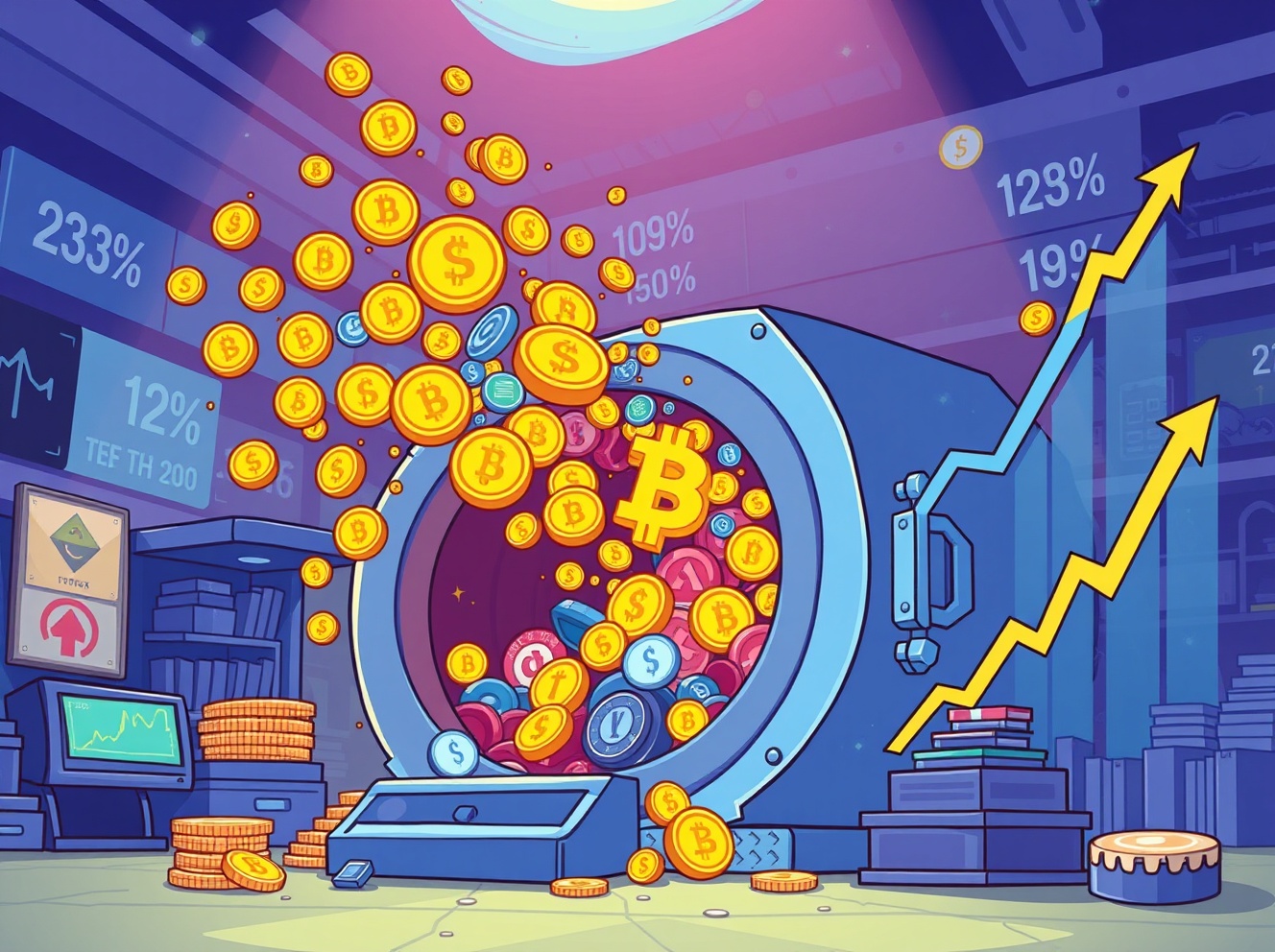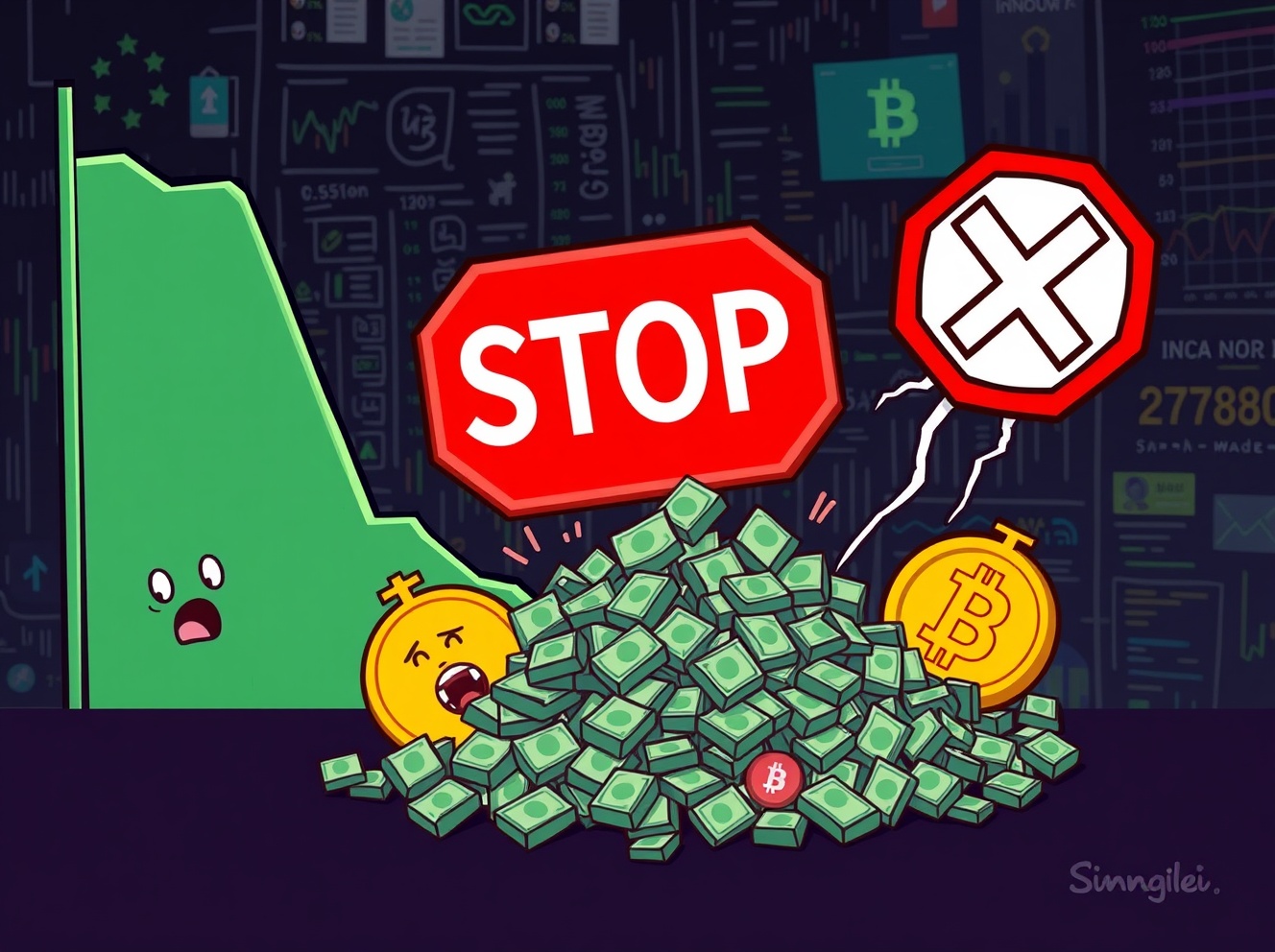
BitcoinWorld DEX Trading Volume Explodes: A Staggering $613.3 Billion Record in October The cryptocurrency world is buzzing with exciting news: DEX trading volume has absolutely exploded, reaching an unprecedented all-time high of $613.3 billion in October! This monumental achievement, as reported by The Block and sourced from DeFi Llama, signals a significant shift in how traders are engaging with digital assets. It’s a clear indicator that decentralized finance (DeFi) continues to gain immense traction, drawing in more users who value autonomy and transparency. What’s Fueling the Record DEX Trading Volume? This remarkable surge in DEX trading volume isn’t just a random spike; it’s a reflection of several underlying trends and growing confidence in decentralized platforms. Several factors are contributing to this incredible growth: Increased User Adoption: More people are discovering the benefits of decentralized exchanges, leading to a broader user base. Innovation in DeFi: Continuous development of new protocols, yield farming opportunities, and liquidity pools attracts capital and activity. Regulatory Uncertainty for CEXs: Some traders are moving towards DEXs to avoid potential regulatory pressures or concerns associated with centralized entities. Enhanced User Experience: While still evolving, many DEXs have made significant strides in improving their interfaces and making them more accessible for everyday users. The numbers speak for themselves. This surge highlights a growing preference for permissionless and censorship-resistant trading environments. Leading the Charge: Uniswap and PancakeSwap’s Dominance When we talk about this record DEX trading volume , two names consistently stand out: Uniswap and PancakeSwap. These platforms have been instrumental in driving the majority of the activity: Uniswap: As a pioneer in the DEX space, Uniswap continues to dominate, recording an impressive $170.9 billion in October. Its robust infrastructure and wide range of supported tokens make it a go-to for many traders. PancakeSwap: Following closely, PancakeSwap secured $101.9 billion in trading volume. Built on the Binance Smart Chain (now BNB Chain), it offers lower transaction fees, appealing to a different segment of the crypto community. Their success underscores the diverse needs of crypto traders and the effectiveness of different blockchain ecosystems in facilitating decentralized trading. The competition between these giants also fosters innovation, benefiting the entire DeFi landscape. DEX vs. CEX: The Shifting Landscape of Crypto Trading Volume Perhaps one of the most compelling insights from this data is the evolving relationship between decentralized and centralized exchanges. The ratio of DEX trading volume to centralized exchange (CEX) trading volume climbed to 19.84% in October. This represents a significant increase of 1.01 percentage points from the previous month. What does this shift signify? It indicates a steady, albeit gradual, erosion of CEX dominance. While CEXs still command the lion’s share, the gap is narrowing. This trend suggests that a growing portion of the crypto market is prioritizing the core tenets of decentralization: user control over funds, transparency, and resistance to censorship. It’s a powerful statement about the future direction of the industry. Navigating the DEX Ecosystem: Benefits and Challenges The appeal of high DEX trading volume isn’t just about the numbers; it’s about the underlying philosophy. Decentralized exchanges offer distinct advantages: Self-Custody: Users retain full control of their assets, eliminating the risk of exchange hacks or freezing of funds. Transparency: All transactions are recorded on a public blockchain, offering unparalleled transparency. Accessibility: Anyone with an internet connection and a crypto wallet can participate, without KYC requirements. However, the DEX landscape isn’t without its challenges. Users often face higher gas fees, particularly on Ethereum-based DEXs, and the interfaces can sometimes be less intuitive for newcomers. Understanding these trade-offs is crucial for anyone looking to engage with decentralized trading. What Does This Record DEX Trading Volume Mean for the Future of Crypto? The astonishing growth in DEX trading volume in October is more than just a fleeting trend; it’s a powerful indicator of the evolving crypto landscape. This momentum suggests that decentralized finance is maturing and becoming an increasingly vital component of the broader financial ecosystem. As technology advances and user experiences improve, we can expect DEXs to continue attracting a larger share of the market. This shift empowers individuals with greater financial autonomy and transparency, aligning with the foundational principles of blockchain technology. The record volumes underscore a growing confidence in permissionless systems and hint at a future where decentralized trading plays an even more central role in how we interact with digital assets. In conclusion, the October surge in DEX trading volume to a staggering $613.3 billion is a landmark achievement for decentralized finance. It highlights the growing maturity and appeal of platforms like Uniswap and PancakeSwap, and signals a significant shift in market dynamics. As the crypto space continues to evolve, DEXs are clearly positioned as a formidable force, offering users a powerful alternative for secure, transparent, and user-controlled trading. Frequently Asked Questions (FAQs) Q1: What is a DEX, and how is it different from a CEX? A decentralized exchange (DEX) is a peer-to-peer marketplace where cryptocurrency transactions occur directly between traders without the need for an intermediary. In contrast, a centralized exchange (CEX) is operated by a company that acts as a third party, holding users’ funds and facilitating trades. DEXs offer greater autonomy and transparency, while CEXs often provide more features and easier onboarding. Q2: Which DEXs contributed most to the record trading volume in October? Uniswap recorded the highest trading volume at $170.9 billion, making it the leading decentralized exchange. PancakeSwap followed with a significant volume of $101.9 billion, demonstrating its strong presence, particularly on the BNB Chain. Q3: Why is the increase in DEX trading volume significant for the crypto market? The surge in DEX trading volume signifies a growing preference among traders for decentralized platforms. It highlights increasing confidence in DeFi’s ability to offer secure, transparent, and user-controlled trading environments. This trend indicates a maturing decentralized finance ecosystem and a potential shift in market share away from traditional centralized exchanges. Q4: Are there any downsides to using decentralized exchanges? While DEXs offer many benefits, they also come with challenges. These can include potentially higher transaction (gas) fees, especially on busy networks like Ethereum, and interfaces that might be less user-friendly for beginners compared to centralized exchanges. Users also bear full responsibility for the security of their private keys. Q5: How does DEX trading volume compare to centralized exchange (CEX) volume? In October, the ratio of DEX to CEX trading volume rose to 19.84%. While CEXs still account for a larger portion of the total trading volume, this increase shows a consistent trend of DEXs gaining market share and becoming a more substantial part of the overall cryptocurrency trading landscape. Found this deep dive into the booming world of DEX trading volume insightful? Don’t keep this valuable information to yourself! Share this article with your friends, fellow crypto enthusiasts, and on your social media channels to spread the word about the incredible growth in decentralized finance. Let’s foster a more informed and empowered crypto community together! To learn more about the latest crypto market trends, explore our article on key developments shaping decentralized finance institutional adoption. This post DEX Trading Volume Explodes: A Staggering $613.3 Billion Record in October first appeared on BitcoinWorld .
Bitcoin World
You can visit the page to read the article.
Source: Bitcoin World
Disclaimer: The opinion expressed here is not investment advice – it is provided for informational purposes only. It does not necessarily reflect the opinion of BitMaden. Every investment and all trading involves risk, so you should always perform your own research prior to making decisions. We do not recommend investing money you cannot afford to lose.
Massive Crypto Futures Liquidation: Over $346 Million Wiped Out in an Hour

BitcoinWorld Massive Crypto Futures Liquidation: Over $346 Million Wiped Out in an Hour The cryptocurrency market just experienced a dramatic event, witnessing a significant crypto futures liquidation . In a startling turn of events, major exchanges saw an astounding $346 million worth of futures contracts liquidated within a single hour. This immediate financial impact serves as a powerful reminder of the inherent volatility and high stakes involved in derivatives trading within the digital asset space. Over the past 24 hours, the total figure swelled to an alarming $1,633 million in liquidated futures, underscoring a period of intense market pressure and rapid price movements. Understanding Crypto Futures Liquidation What exactly is a crypto futures liquidation , and why does it matter? Futures contracts are agreements to buy or sell an asset at a predetermined price on a future date. Traders often use leverage, borrowing funds to amplify their potential returns. While leverage can boost profits, it also magnifies losses. A liquidation occurs when a trader’s position falls below a certain margin requirement, meaning they no longer have enough collateral to cover potential losses. When this happens, the exchange automatically closes the position to prevent further losses. This mechanism protects the exchange and the lender but can be devastating for the trader. It is a common occurrence in highly volatile markets, and its scale often reflects significant price swings. The Recent Shockwave: $346 Million in an Hour The recent event saw a staggering $346 million in crypto futures liquidation within a mere sixty minutes. This rapid unwinding of positions indicates an abrupt and substantial price movement that caught many leveraged traders off guard. Such swift liquidations often trigger a cascading effect, where forced selling further drives down prices, leading to more liquidations. This phenomenon can exacerbate market downturns, creating a ‘liquidation cascade’ that accelerates price declines. The 24-hour total of $1.633 billion further highlights the widespread impact across various cryptocurrencies and trading pairs. Bitcoin and Ethereum, being the largest assets, typically account for a significant portion of these liquidations due to their high trading volumes and open interest in futures markets. Why Do These Massive Liquidations Happen? Several factors contribute to large-scale crypto futures liquidation events: Sudden Price Swings: Unexpected news, whale movements, or macroeconomic factors can cause rapid price changes, pushing leveraged positions into negative territory. High Leverage: Many traders use extremely high leverage (e.g., 50x, 100x), meaning even small price movements can lead to liquidation. Market Contagion: A liquidation in one asset or exchange can sometimes spill over, affecting sentiment and prices across the broader market. Lack of Stop-Loss Orders: Traders who do not set appropriate stop-loss orders are more vulnerable to sudden market shifts. These events serve as a stark reminder of the risks associated with highly leveraged trading in an unregulated and often unpredictable market. Impact on Traders and the Broader Market For individual traders, a crypto futures liquidation can mean significant, often total, loss of their invested capital. It is a painful experience that can deter participation in futures markets. Beyond individual losses, these events also affect overall market sentiment. Large liquidations can: Indicate bearish sentiment if the liquidations are predominantly long positions. Increase market volatility as forced selling adds to price pressure. Shake investor confidence, especially among newer participants. However, liquidations also clear out over-leveraged positions, potentially setting the stage for a healthier, more sustainable market rebound once the dust settles. Navigating Volatility: Actionable Insights for Traders Understanding the risks of crypto futures liquidation is crucial. Here are some actionable insights for traders: Manage Leverage Wisely: Avoid excessive leverage. Use only what you are comfortable losing. Implement Stop-Loss Orders: Always set stop-loss orders to limit potential losses automatically. Diversify Your Portfolio: Do not put all your capital into highly leveraged futures positions. Stay Informed: Keep abreast of market news, economic indicators, and technical analysis to anticipate potential price movements. Understand Margin Requirements: Be aware of the margin levels required by your exchange and monitor your positions closely. Responsible trading practices are paramount to surviving and thriving in the volatile crypto futures market. The recent $346 million crypto futures liquidation event serves as a powerful testament to the high-risk, high-reward nature of derivatives trading in the cryptocurrency space. While such events can be devastating for individual traders caught on the wrong side, they are an intrinsic part of a dynamic market. For those engaging with futures, prudence, risk management, and continuous learning are not just advisable but essential for long-term success. Understanding these market mechanics helps traders navigate the complexities and make more informed decisions, ultimately fostering a more resilient trading strategy. Frequently Asked Questions (FAQs) Q1: What does it mean when futures are ‘liquidated’? A1: Liquidation occurs when a trader’s leveraged position in a futures contract falls below the required margin level. The exchange automatically closes the position to prevent further losses, resulting in the loss of the trader’s collateral. Q2: Why did such a large crypto futures liquidation happen so quickly? A2: Large liquidations happen quickly due to sudden and significant price movements in the underlying asset. When prices move sharply against many highly leveraged positions simultaneously, it triggers a cascade of automatic closures. Q3: How does leverage contribute to crypto futures liquidation? A3: Leverage amplifies both gains and losses. While it can increase profits on favorable price movements, it also means a smaller adverse price movement can quickly deplete a trader’s margin, leading to liquidation. Q4: Are crypto futures liquidations common? A4: Yes, liquidations are a common occurrence in the volatile cryptocurrency futures market, especially during periods of high price fluctuations. The scale of liquidations varies significantly. Q5: What can traders do to avoid crypto futures liquidation? A5: Traders can minimize the risk of liquidation by using lower leverage, setting strict stop-loss orders, diversifying their portfolio, and closely monitoring market conditions and their margin levels. If you found this article insightful, please consider sharing it with your network on social media. Your shares help us continue to provide valuable insights into the dynamic world of cryptocurrency. To learn more about the latest crypto market trends, explore our article on key developments shaping crypto market price action. This post Massive Crypto Futures Liquidation: Over $346 Million Wiped Out in an Hour first appeared on BitcoinWorld . Bitcoin World

Crypto Futures Liquidation: Massive $470 Million Wipeout Shakes Markets
BitcoinWorld Crypto Futures Liquidation: Massive $470 Million Wipeout Shakes Markets The crypto market just witnessed a dramatic event: a staggering $470 million worth of crypto futures liquidation occurred in a single hour. This sudden wipeout is part of an even larger trend, with over $1.75 billion in futures positions liquidated across major exchanges in the past 24 hours. For many traders, this represents a significant financial blow and a stark reminder of the inherent volatility in the digital asset space. What does this mean for your trading strategy? What Exactly is a Crypto Futures Liquidation? When we talk about crypto futures liquidation , it might sound like complex financial jargon, but let’s break it down simply. Futures contracts allow traders to bet on the future price of an asset without owning the asset itself. Many traders use leverage, borrowing funds to amplify their potential gains. However, leverage also magnifies losses. If the market moves against a leveraged position, and the trader’s margin (the collateral they put up) falls below a certain level, the exchange automatically closes their position to prevent further losses. This forced closure is what we call a liquidation. It’s a crucial mechanism to protect both traders and exchanges from excessive debt. Futures Contracts: Agreements to buy or sell an asset at a predetermined price on a future date. Leverage: Using borrowed capital to increase potential returns. Margin: The collateral required to open and maintain a leveraged position. Liquidation: The automatic closure of a leveraged position by an exchange when a trader’s margin can no longer cover potential losses. Why Do Massive Crypto Futures Liquidations Occur So Suddenly? The recent surge in crypto futures liquidation events, like the $470 million hourly figure, often stems from rapid price movements. Cryptocurrencies are known for their extreme volatility. A sudden drop or pump in price can trigger a chain reaction. For instance, if Bitcoin’s price sharply declines, it can push many leveraged long positions (bets that the price will go up) into liquidation. As these positions are closed, it can add selling pressure, further driving down prices and triggering more liquidations in a cascading effect. This is particularly true during periods of high market uncertainty or significant news. Several factors contribute to these sudden, large-scale liquidations: Market Volatility: Unpredictable and swift price swings. High Leverage: Many traders use substantial leverage, making their positions highly sensitive to price changes. Cascading Effects: One liquidation can trigger others, creating a domino effect. Stop-Loss Hunting: Large market players can sometimes manipulate prices to trigger clusters of stop-loss orders and liquidations. Navigating Volatile Waters: How Can Traders Protect Against Crypto Futures Liquidation? Given the inherent risks, how can traders better protect themselves from sudden crypto futures liquidation ? Effective risk management is paramount. Understanding your exposure and setting clear boundaries can make a significant difference. Here are some actionable insights: Manage Leverage Wisely: Avoid excessive leverage. While it can amplify gains, it dramatically increases liquidation risk. Use Stop-Loss Orders: These automatically close your position if the price hits a predetermined level, limiting potential losses. Monitor Market Conditions: Stay informed about market news, sentiment, and technical indicators. Diversify: Don’t put all your capital into a single leveraged position. Maintain Sufficient Margin: Ensure you have enough collateral to withstand minor price fluctuations without being liquidated. By adopting these strategies, traders can significantly reduce their vulnerability to the unpredictable nature of the crypto market and the threat of a swift crypto futures liquidation . The Broader Impact of Recent Crypto Futures Liquidation Events Beyond the individual trader, massive crypto futures liquidation events have broader implications for the entire crypto ecosystem. Such significant liquidations can signal a period of heightened fear or uncertainty in the market. They can also temporarily depress prices as forced selling occurs, affecting spot markets as well. While these events are a normal, albeit dramatic, part of leveraged trading, their scale underscores the need for caution and robust risk management practices across the board. The $470 million liquidation in one hour and the $1.75 billion over 24 hours are not just numbers; they represent substantial capital shifts and market sentiment. These figures serve as a powerful reminder for both novice and experienced traders to approach leveraged trading with extreme care and a deep understanding of the potential pitfalls. The market is constantly evolving, and being prepared for such rapid shifts is crucial for long-term success. In conclusion, the recent $470 million crypto futures liquidation within an hour, alongside a massive $1.75 billion over 24 hours, highlights the dynamic and often brutal nature of leveraged cryptocurrency trading. While futures offer opportunities for significant gains, they come with substantial risks, primarily the threat of liquidation. Understanding what triggers these events and implementing robust risk management strategies are not just recommendations; they are necessities for anyone participating in this high-stakes environment. Stay informed, trade responsibly, and prioritize capital preservation. Frequently Asked Questions (FAQs) What is crypto futures liquidation? Crypto futures liquidation is the forced closure of a trader’s leveraged position by an exchange when their margin collateral can no longer cover potential losses due to adverse price movements. Why did $470 million in crypto futures get liquidated in one hour? Such a large liquidation typically occurs due to rapid and significant price movements in the underlying cryptocurrency, triggering stop-loss orders and margin calls across numerous highly leveraged positions simultaneously. How can I avoid crypto futures liquidation? You can reduce the risk of liquidation by using less leverage, setting effective stop-loss orders, maintaining sufficient margin, and continuously monitoring market conditions. Does crypto futures liquidation affect the spot market? Yes, large-scale liquidations can indirectly affect the spot market by increasing selling pressure, which can lead to temporary price declines as positions are forcefully closed. Is futures trading safe in crypto? Futures trading in crypto carries significant risk, especially with high leverage, due to market volatility. It is not inherently “safe” and requires extensive knowledge, experience, and strict risk management. Was this article helpful in understanding the recent crypto futures liquidation events? Share your thoughts and insights with your network! Help others navigate the complexities of crypto trading by sharing this article on your social media platforms. To learn more about the latest crypto market trends, explore our article on key developments shaping cryptocurrency price action. This post Crypto Futures Liquidation: Massive $470 Million Wipeout Shakes Markets first appeared on BitcoinWorld . Bitcoin World











